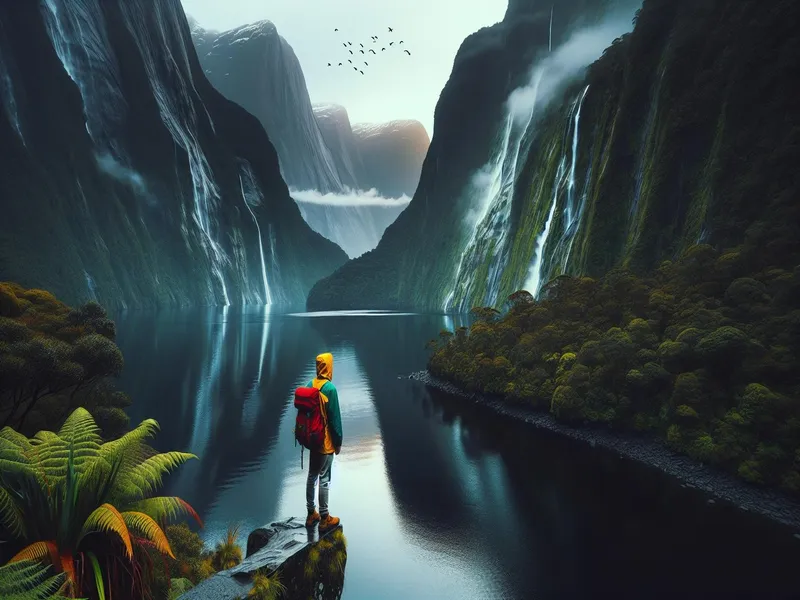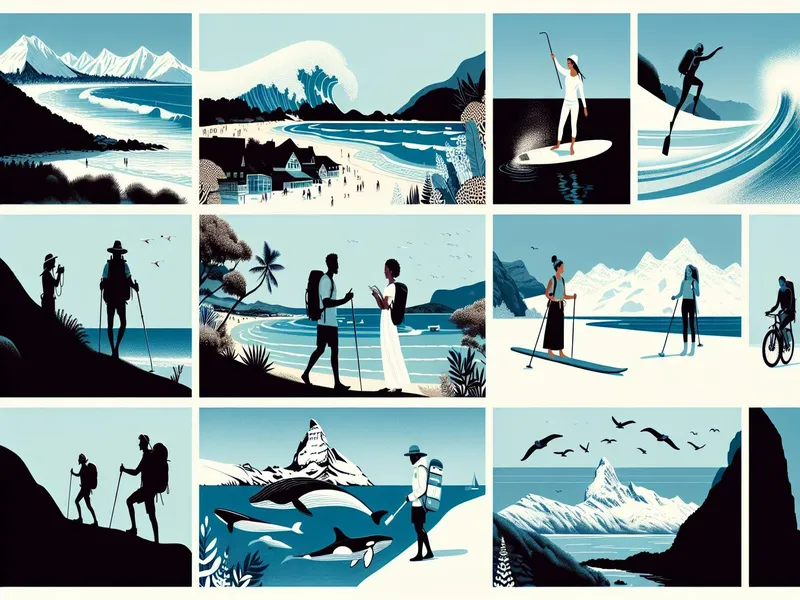
From the rugged mountains of New Zealand to the pristine beaches of Fiji, there’s something for every nature lover.
Yet, without proper planning, you might miss out on hidden gems or find yourself unprepared for the region’s diverse climates. This can lead to a less-than-ideal experience, leaving you feeling like you’ve wasted both time and money.
I’ve explored many corners of Oceania and know firsthand what it takes to make an outdoor trip unforgettable. With years of travel under my belt, I’ll guide you through must-see spots and essential tips.
Whether you’re a thrill-seeker looking for your next adrenaline rush or someone who enjoys leisurely hikes and scenic views, this guide will cater to your preferences. Let’s jump into how you can make the most of your outdoor travel in Oceania. For more travel activity ideas, check out our comprehensive travel activities guide.
Best Destinations for Outdoor Travel in Oceania
Oceania’s a treasure trove of outdoor adventures. Whether you’re into hiking, snorkeling, or just lounging on pristine beaches, this region has something for everyone. Let’s jump into some must-visit spots.
Australia
Australia’s vast landscapes offer incredible outdoor experiences. I remember hiking through the Blue Mountains—each turn revealed stunning vistas and hidden waterfalls. If you love the ocean, head to the Great Barrier Reef. Snorkeling there feels like you’re in an episode of Planet Earth. For a touch of the Outback, Uluru’s red rock formations are nothing short of magical at sunset.
Highlights:
- Blue Mountains: Ideal for hikes with breathtaking views.
- Great Barrier Reef: Perfect for snorkeling and underwater exploration.
- Uluru: Awe-inspiring rock formations best seen at sunset.
New Zealand
New Zealand is an adventurer’s paradise. When I visited Queenstown, it felt like stepping into a natural playground—bungee jumping off bridges and jet boating through canyons were just part of my itinerary! The Milford Track hike offers picturesque scenery that’s straight out of a fantasy novel (think Lord of the Rings). Rotorua’s geothermal wonders make it a unique spot where you can relax in hot springs after exploring geysers.
Highlights:
- Queenstown: Known as the adventure capital with activities like bungee jumping.
- Milford Track: Offers scenic hikes with stunning landscapes.
- Rotorua: Features geothermal attractions perfect for relaxation.
Fiji
Fiji’s islands are perfect for both thrill-seekers and those looking to unwind. I’ve kayaked around its crystal-clear lagoons, discovering secluded beaches that felt like my own private slice of paradise. Diving here is world-class; imagine swimming alongside vibrant coral reefs teeming with marine life. For something truly special, try visiting one of Fiji’s traditional villages—you’ll get a genuine taste of local culture and hospitality.
Highlights:
- Kayaking: Explore serene lagoons and hidden beaches.
- Diving: Experience vibrant coral reefs brimming with life.
- Cultural Visits: Engage with Fijian traditions in local villages.
Papua New Guinea
Papua New Guinea is less traveled but offers raw beauty waiting to be explored. Trekking through Kokoda Trail was challenging yet rewarding—I felt connected to history every step along this World War II path. Birdwatching here is unparalleled; spotting Birds-of-Paradise feels almost mythical. Don’t miss diving in Kimbe Bay where untouched reefs showcase biodiversity unlike any other place I’ve been.
- Kokoda Trail: Historic trek offering both challenge and reward.
- Birdwatching: Home to exotic Birds-of-Paradise.
- Kimbe Bay Diving: Discover unspoiled reefs rich in marine life.
Top Activities for Outdoor Enthusiasts

If you’re an outdoor enthusiast, Oceania is your playground. From New Zealand’s rugged terrain to Fiji’s crystal-clear waters, the region offers something for everyone. Let’s jump into some top activities that’ll make your trip unforgettable.
Hiking and Trekking
Hiking in Oceania feels like stepping into another world. New Zealand‘s Milford Track is a trekker’s dream—think lush rainforests and majestic waterfalls. If you want something off the beaten path, try Tasmania‘s Overland Track. It’s got everything from alpine meadows to glacial lakes.
- Milford Track (NZ): 33 miles of stunning landscapes.
- Overland Track (TAS): A 40-mile adventure through diverse terrains.
Remember to pack layers; weather can be unpredictable!
Surfing and Water Sports
Oceania is a surfer’s paradise. Picture this: catching waves at Australia’s famous Bondi Beach or riding the swells in Fiji’s Cloudbreak spot. For those who prefer calmer waters, paddleboarding around New Zealand’s Bay of Islands offers serene beauty.
- Bondi Beach (AUS): Perfect for all skill levels.
- Cloudbreak (Fiji): Ideal for experienced surfers.
- Bay of Islands (NZ): Great for paddleboarding and snorkeling.
Don’t forget sunscreen—those UV rays are no joke!
Wildlife and Bird Watching
You’ll be amazed by the unique wildlife here. Imagine spotting kangaroos while hiking in Australia or watching kiwis scuttle around at night in New Zealand. In Papua New Guinea, birdwatchers can find exotic species like the Raggiana bird-of-paradise.
- Australia: Kangaroo Island for close encounters.
- New Zealand: Stewart Island for kiwi watching.
- Papua New Guinea: Varirata National Park for bird enthusiasts.
Bring binoculars—it makes a huge difference!
Camping and Glamping
Whether you’re into roughing it or prefer a bit of luxury, camping options abound. Pitch your tent under starry skies in Australia’s Outback or opt for glamping in one of Fiji’s eco-resorts where you get nature plus comfort.
- Australian Outback: Perfect for traditional camping.
- Fiji Eco-resorts: Combines nature with luxury amenities.
Seasonal Travel Tips

When traveling in Oceania, planning around the seasons is crucial. Trust me, you don’t want to pack for summer when it’s winter down under!
Summer Adventures
Summer in Oceania, typically from December to February, offers endless outdoor activities. I remember hiking up New Zealand’s Roys Peak—sunshine and panoramic views made it unforgettable.
- Beach Fun: Head to Australia’s Bondi Beach for surfing or chilling on the sand.
- Hiking Trails: Explore Tasmania’s Overland Track while enjoying warm weather.
- Water Sports: Jump into Fiji’s clear waters for snorkeling or kayaking.
Pack your sunscreen; you’ll need it under that strong sun!
Winter Escapades
Winter runs from June to August and brings a different set of adventures. One chilly July, I found myself skiing down the slopes at Queenstown’s Remarkables.
- Snow Sports: Hit New Zealand’s ski resorts like Coronet Peak.
- Wildlife Watching: Spot humpback whales along Australia’s coastline.
- Cultural Festivals: Experience Matariki (Māori New Year) celebrations in New Zealand.
Don’t forget your thermal layers; those mountain winds can be biting!
Rainy Season Considerations
The rainy season varies but often hits between November and April. During my trip to Papua New Guinea in March, sudden showers were a norm but didn’t dampen my spirit.
- Pack Smart: Waterproof gear is essential—think rain jackets and waterproof bags.
- Plan Activities Wisely: Opt for indoor attractions like museums during heavy rains.
- Stay Flexible: Weather changes fast; have backup plans ready.
Safety and Health Precautions
When you’re planning an outdoor adventure in Oceania, safety and health should be top of mind. Trust me, there’s nothing worse than being unprepared when you’re miles away from civilization.
Essential Gear and Equipment
Packing the right gear can make or break your trip. Imagine hiking through New Zealand’s Milford Track without proper footwear—ouch! You’ll need:
- Sturdy Hiking Boots: Avoid blisters and sprained ankles.
- Weather-Appropriate Clothing: Layers are your friends; Oceania’s weather can be unpredictable.
- First-Aid Kit: Always have basics like band-aids, antiseptic wipes, and pain relievers.
- Navigation Tools: GPS devices or traditional maps (batteries die but paper doesn’t).
I once forgot my rain jacket on a trek in Tasmania—it rained the entire day. Learn from my mistake: always check your packing list twice!
Exploring Remote Areas
Oceania has some truly remote spots. If you’re exploring places like Papua New Guinea’s Kokoda Trail, preparation is key.
- Inform Someone of Your Plans: Let friends or family know your itinerary.
- Emergency Communication Devices: Satellite phones or personal locator beacons (PLBs) can save lives.
- Know Basic Survival Skills: How to start a fire or purify water could come in handy.
Think about it this way: if Frodo had Google Maps in Mordor, his journey might’ve been smoother. Plan meticulously to avoid unexpected detours.
Local Wildlife Safety
Oceania’s wildlife is fascinating but can be dangerous. Take Australia’s snakes and spiders—they’re not just myths!
- Maintain Distance From Wildlife: Don’t feed animals; it disrupts their natural behavior.
- Learn About Dangerous Species: Understand which creatures pose risks in different areas.
- Carry Anti-Venom Kits if Needed: In areas known for venomous animals, these kits are life-savers.
While camping near Uluru, I stumbled upon a kangaroo family at dawn. It was magical yet reminded me to keep respectful distances—wildlife deserves space too.
Budgeting for Your Trip
Planning outdoor travel in Oceania can be exciting, but keeping an eye on your budget is crucial. Here’s a breakdown to help you manage costs and make the most of your adventure.
Cost of Activities
Outdoor activities in Oceania vary widely in cost. For example:
- Hiking: Many trails, like New Zealand’s Milford Track, have minimal fees, usually around $10-$20 for conservation upkeep.
- Snorkeling/Diving: A day trip to the Great Barrier Reef might set you back about $150-$200.
- Surfing: Renting a surfboard at Bondi Beach typically costs $20 per hour.
Keep in mind that some national parks may charge entrance fees ranging from $10 to $50. It’s wise to check websites for updated prices before heading out.
Accommodation Options
From luxury resorts to budget hostels, Oceania offers diverse accommodation options:
- Camping: If you’re adventurous, camping is an affordable choice. Campsites in Australia and New Zealand typically cost between $15 and $40 per night.
- Hostels: Great for meeting fellow travelers, with prices ranging from $20 to $50 per night.
- Airbnb/Hotels: Offer more comfort but come with higher costs—expect rates from $80 upwards.
I once stayed at a charming hostel near Queenstown’s lakefront for just $30 a night!
Affordable Travel Tips
Travel smartly without very costly:
- Off-season Travel: Avoid peak seasons (December-February) when everything’s pricier.
- Local Eats: Dine where locals do; street food and local markets are both delicious and cheap.
- Public Transport: Use buses or trains instead of taxis; they’re cheaper and often more scenic.
To Sum Up
Exploring the outdoor wonders of Oceania offers unparalleled experiences. From the dramatic landscapes and unique wildlife to thrilling and leisurely activities, there’s something for everyone. Whether you’re hiking in New Zealand, snorkeling in Fiji, or camping in the Australian Outback, proper planning enhances every adventure.
Remember to consider seasonal variations and pack accordingly. Safety is paramount; always prepare with essential gear and inform others of your plans. Budgeting can help make these incredible experiences more accessible without very costly.
Oceania’s diversity ensures unforgettable outdoor adventures await at every turn. So get out there and start exploring!